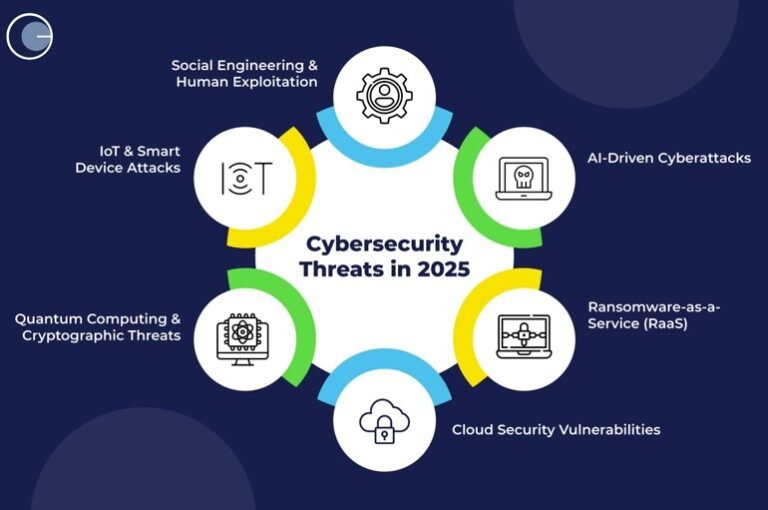Cybersecurity in 2025 is no longer just about firewalls and antivirus software. The digital landscape has evolved, bringing with it more sophisticated and diverse threats. Here’s a breakdown of the most pressing cybersecurity challenges this year and actionable steps to safeguard yourself and your organization.
- AI-Powered Cyberattacks
Artificial Intelligence has become a double-edged sword. While it offers advancements in various fields, Cybersecurity are leveraging AI to enhance their attacks. From crafting convincing phishing emails to generating deepfake videos of executives, AI enables attackers to deceive even the most vigilant individuals.
Protection Tips:
- Implement AI-driven security solutions that can detect and respond to threats in real-time.
- Educate employees about the risks of AI-generated content and the importance of verifying sources.
- Regularly update and patch systems to close vulnerabilities that AI tools might exploit.
- Ransomware-as-a-Service (RaaS)
Ransomware attacks have become more accessible due to the RaaS model, where cybercriminals offer ransomware tools to others for a fee. This democratization of cybercrime has led to an increase in attacks targeting various sectors, including healthcare, finance, and manufacturing.
Protection Tips:
- Maintain regular backups of critical data and ensure they are stored offline or in a secure cloud environment.
- Implement network segmentation to limit the spread of ransomware.
- Train staff to recognize phishing attempts and other social engineering tactics.
- Supply Chain Vulnerabilities
Cyberattacks are increasingly targeting third-party vendors and suppliers to gain access to larger organizations. A notable example is the 2025 cyberattack on Jaguar Land Rover, which halted production across its global manufacturing sites due to compromised IT systems.
Protection Tips:
- Conduct thorough security assessments of all third-party vendors.
- Require vendors to adhere to strict cybersecurity standards and practices.
- Monitor and audit third-party access to your systems regularly.
- Deepfake Fraud
Deepfake technology has advanced to the point where it’s challenging to distinguish between real and fabricated audio or video. Cybercriminals are using deepfakes to impersonate company executives, tricking employees into transferring funds or divulging sensitive information.
Protection Tips:
- Implement multi-factor authentication (MFA) to verify identities.
- Establish clear communication protocols for financial transactions.
- Use deepfake detection tools to analyze and verify media content.
- State-Sponsored Espionage
Nations are increasingly using cyberattacks as tools of espionage. Groups like Kimsuky from North Korea and Chinese state-sponsored hackers are employing AI to infiltrate organizations, steal sensitive information, and disrupt operations.
Protection Tips:
- Employ threat intelligence services to stay informed about potential state-sponsored threats.
- Implement a zero-trust security model, assuming no entity inside or outside the organization is trustworthy by default.
- Regularly update and patch systems to protect against known exploits.
- Quantum Computing Risks
While still in its infancy, quantum computing poses a future threat to current encryption methods. The UK’s National Cyber Security Centre has warned that by 2035, quantum computers could potentially break widely used encryption algorithms.
Protection Tips:
- Begin transitioning to quantum-resistant encryption algorithms.
- Stay informed about advancements in quantum computing and their implications for cybersecurity.
- Collaborate with industry peers to share knowledge and best practices regarding quantum security.
- Voice Phishing (Vishing) and Social Engineering
Cybercriminals are increasingly using voice phishing to deceive individuals into revealing sensitive information. By impersonating trusted figures over the phone, attackers can manipulate victims into providing access credentials or financial details.
Protection Tips:
- Verify the identity of callers before sharing any information, especially sensitive data.
- Educate employees about common social engineering tactics and the importance of skepticism.
- Implement call-back procedures to confirm requests made over the phone.
- IoT Device Exploits
The proliferation of Internet of Things (IoT) devices has expanded the attack surface for cybercriminals. Many IoT devices have weak security measures, making them prime targets for exploitation.
Protection Tips:
- Change default passwords on all IoT devices and use strong, unique passwords.
- Regularly update firmware and software on IoT devices.
- Isolate IoT devices on separate networks to limit potential damage from breaches.
- Cloud Security Misconfigurations
As organizations increasingly migrate to cloud services, misconfigurations in cloud settings have become a significant vulnerability. These missteps can expose sensitive data to unauthorized access.
Protection Tips:
- Regularly audit cloud configurations to ensure they adhere to best security practices.
- Implement access controls and encryption for data stored in the cloud.
- Provide training for staff managing cloud services to recognize and rectify misconfigurations.
- Insider Threats
Not all threats come from external sources. Insider threats, whether malicious or accidental, can lead to significant data breaches and operational disruptions.
Protection Tips:
- Monitor user activity for unusual behavior that may indicate malicious intent.
- Implement least privilege access controls, ensuring employees have only the necessary access to perform their duties.
- Provide regular training on data protection and the importance of safeguarding sensitive information.
Conclusion
Cybersecurity in 2025 is multifaceted, with threats evolving rapidly in complexity and sophistication. By staying informed about emerging threats and implementing proactive security measures, individuals and organizations can better defend against potential cyberattacks. Remember, cybersecurity is not just an IT responsibility but a collective effort that requires vigilance, education, and collaboration.
